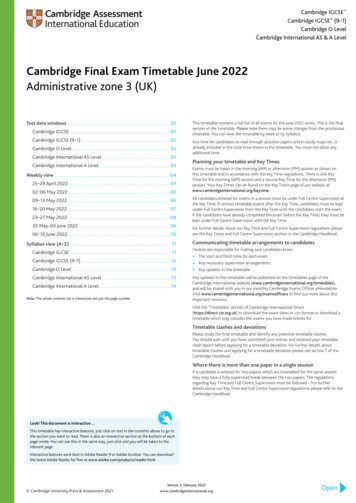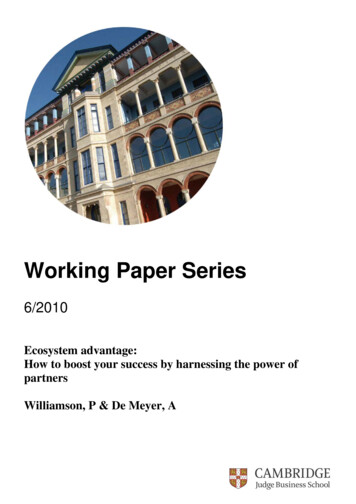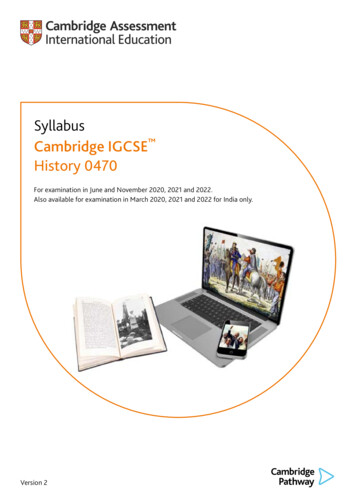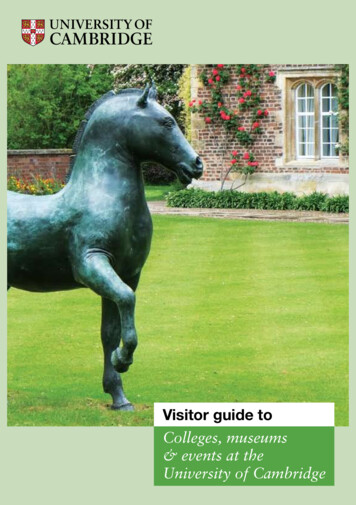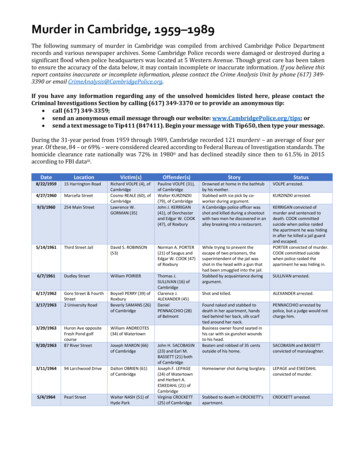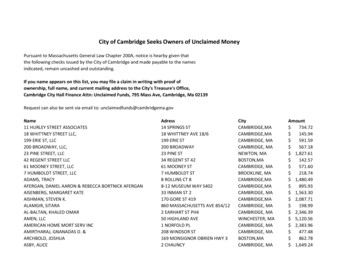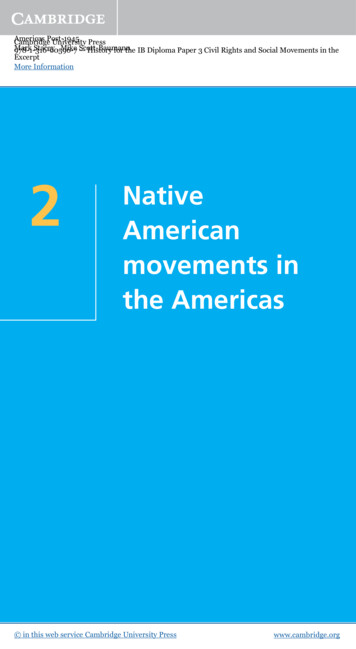
Transcription
AmericasCambridgePost-1945University PressMark Stacey , Mike Scott-Baumann978-1-316-60596-7— History for the IB Diploma Paper 3 Civil Rights and Social Movements in theExcerptMore Information2NativeAmericanmovements inthe Americas in this web service Cambridge University Presswww.cambridge.org
AmericasCambridgePost-1945University PressMark Stacey , Mike Scott-Baumann978-1-316-60596-7— History for the IB Diploma Paper 3 Civil Rights and Social Movements in theExcerptMore InformationNative American movements in the AmericasIntroductionThis chapter deals with the development of Native Americanmovements in the Americas, and focuses in particular on the UnitedStates. It will examine the situation of Native American peoples at theend of the Second World War, in the context of colonial rule and thedevelopment of the modern states. The chapter will then seek to addresswhy the Native American movements emerged in the 1960s and whattheir aims and grievances were, before considering how successful themovements were in achieving those aims. Finally, it will look at how farthe civil rights of Native Americans changed in the post-war period.The chapter also includes case studies of indigenous peoples in othercountries of the Americas.TIMELINE1944 National Congress of American Indians (NCAI) formed1956 Indian Vocational Training Act (1956) passed1958 Battle of Hayes Pond between Ku Klux Klan (KKK) and LumbeeIndians1961 National Indian Council (NIC) formed in Canada; NationalIndian Youth Council (NIYC) formed1968 American Indian Movement (AIM) formed; Civil Rights Actcontains Indian ‘Bill of Rights’1969 Nov: Occupation of Alcatraz by Navajo Indians1970 Publication of Bury My Heart at Wounded Knee by Dee Brown1972 AIM leads Trail of Broken Treaties to Washington, DC1973 Armed confrontation between AIM members and governmentoficials at Wounded Knee1975 Indian Self-Determination Act passed1978 American Indian Religious Freedom Act passed1992 Rigoberta Menchú wins Nobel Peace Prize for work on behalfof Guatemalan Indians21 in this web service Cambridge University Presswww.cambridge.org
AmericasCambridgePost-1945University PressMark Stacey , Mike Scott-Baumann978-1-316-60596-7— History for the IB Diploma Paper 3 Civil Rights and Social Movements in theExcerptMore Information2Civil Rights and Social Movements in the Americas Post–45KEY QUESTIONS What was the situation of Native American populations in 1945? Why did Native American movements emerge in the immediatepost-war period? What were the goals of the reformers in the Native Americanmovements? How did Native Americans seek to afirm their identities during the1960s? To what extent did the civil rights of Native Americans change fromthe 1960s to the 1980s?Overview US federal policy towards Native Americans was paternalisticthrough most of the 20th century. There was an expectation thattribes would die out eventually but this gradually faded as thepopulation recovered. Native Americans are comprised of discrete tribes who were oftenunwilling to work together, this made coordination more diicultthan in the African American and women’s rights movement The formation of the National Congress of American Indians(NCAI) in 1944 gave Native Americans a national voice to addressthe issue of rights for the irst time. Native Americans faced considerable disadvantages in terms ofunemployment, healthcare and education. The slow progress of change led to the creation of the NationalIndian Youth Council (NIYC) in 1961, which was inspired by theblack civil rights movement. The American Indian Movement (AIM), founded in 1968, usedincreasingly radical and media-friendly stunts to put pressure on thefederal government, such as the occupation of Alcatraz and the Trailof Broken Treaties.22 in this web service Cambridge University Presswww.cambridge.org
AmericasCambridgePost-1945University PressMark Stacey , Mike Scott-Baumann978-1-316-60596-7— History for the IB Diploma Paper 3 Civil Rights and Social Movements in theExcerptMore InformationNative American movements in the Americas By the 1980s, advances had been made in terms of legislation andaddressing social problems, but Native Americans were still the mostdisadvantaged group in US society. In other parts of the Americas, indigenous people were similarlydisadvantaged. They were more frequently disenfranchised (deprivedof the right to vote) than in the US.2.1 What was the situation ofNative American populationsin 1945?Colonisation and modernisationThe indigenous peoples of North and South America sufered heavilyat the hands of the European colonists who began arriving after HernánCortés's victory over the Aztec Empire in 1519. In the following twocenturies over ¾ million Spanish people arrived in Latin America.The Spanish in the South and British and French in the Northbrought disease and sought to ‘civilise’ native people, while native landswere taken for derisory sums, most notably the island of Manhattanfor 24 worth of glass beads and cloth. Traditions were disrespectedand suppressed, but worse still was the impact of alcohol, which wasintroduced to the Native Americans by the white settlers. On bothcontinents, indigenous peoples were treated as subhuman.As the colonial period developed into the agricultural and industrialrevolutions, more and more land was needed to house and feed theexpanding population. The subsequent impact of these forces ofmodernisation on indigenous people was even more damaging than thearrival of the Europeans.Skirmishes between settlers and natives were frequent and were laterimmortalised in (ictional) cowboy ilms. Over 50 ‘wars’ were fought inthe lands west of the Mississippi in the period from 1823 to 1900. Attheir conclusion treaties with the natives were signed which purportedto recognise certain native rights to lands and ishing areas as well aspromises of investment in the needs of the tribes.23 in this web service Cambridge University Presswww.cambridge.org
AmericasCambridgePost-1945University PressMark Stacey , Mike Scott-Baumann978-1-316-60596-7— History for the IB Diploma Paper 3 Civil Rights and Social Movements in theExcerptMore Information2Civil Rights and Social Movements in the Americas Post–45In practice these treaties, though legally binding, were rarely honoured,owing to the superiority of settler numbers and forces and the racialand religious prejudices against native people that persisted. Theseprejudices were reinforced by the concept of Social Darwinism. Theidea that certain races (here meaning white Europeans) were superior toothers was being hotly debated at the time. Social Darwinism provided apseudo-scientiic justiication for anything from ignoring native customsto genocide.Theory of KnowledgeHistory and language:The term ‘genocide’, meaning the deliberate killing of alarge group, especially those connected by nationality,ethnicity or religion, is fraught with dificult connotations.The Second World War genocide of the Jews is widelyrecognised but other large-scale deaths such as theArmenian ‘genocide’ of 1915 are disputed. As you workthrough this chapter consider whether the US governmentcan be seen as having perpetrated a genocide againstNative Americans and why the term is problematic.The ideas of the free market also contributed to the colonisation ofNative American lands. The opening and exploitation of new territorieswas seen as part of a natural progression of capitalism, and moreprogressive Europeans expected indigenous people to either assimilateor die out.Railroads and settlements brought displacement, starvation and, in somecases – such as the Trail of Tears following the Indian Removal Act of1830 – genocide. These genocides were achieved using forced relocationto reservations, ‘treaties’ that were little more than diktats, and outrightwarfare and extermination campaigns carried out in both North andSouth America.ACTIVITYFind out more about the Indian Removal Act of 1830 and the Trailof Tears. Why does the term ‘genocide’ apply to events such as theTrail of Tears?24 in this web service Cambridge University Presswww.cambridge.org
AmericasCambridgePost-1945University PressMark Stacey , Mike Scott-Baumann978-1-316-60596-7— History for the IB Diploma Paper 3 Civil Rights and Social Movements in theExcerptMore InformationNative American movements in the AmericasFigure 2.1: A 1911 advertisement promoting the sale of former Native Americanland which had been taken by the government.US paternalism and the 1887 Dawes ActAs the European colonists moved west and settled the land the NativeAmericans were forced of and into government-allocated reservations.Native Americans had no desire to become assimilated into themainstream of American society. However, the government’s attitudetowards the Native Americans was guided by paternalism. A paternalisticgovernment is one that interferes with people’s lives, against their will,‘for their own good’. In 1887, the US Congress passed the GeneralAllotment Act (also known as the Dawes Act). The aim of the act was tobreak up native reservation lands in order to ‘free’ Native Americans toassimilate into the mainstream.The idea was that the reservations would be divided up among familiesto give them land of their own. Historian Niall Ferguson calls this ideaof the property-owning democracy one of the ‘killer apps’ (jargon foran exceptional computer application) of Western economic success, butthe concept of ‘owning’ anything was alien to the Native Americans25 in this web service Cambridge University Presswww.cambridge.org
AmericasCambridgePost-1945University PressMark Stacey , Mike Scott-Baumann978-1-316-60596-7— History for the IB Diploma Paper 3 Civil Rights and Social Movements in theExcerptMore Information2Civil Rights and Social Movements in the Americas Post–45and unworkable in the often desolate reservation territory. HistorianHoward Zinn claims that, in fact, much of this land was taken by whitespeculators who suspected there might be commercial value in it orunder it, and reservations – now reduced in size – remained.Over time it became clear that the Dawes Act was a disaster. ManyNative American families were forced to abandon their barrensmallholdings and head to the cities. Their situation was exacerbatedduring the Great Depression of the 1930s, because their lack of landmeant they did not qualify for federal aid as larger-scale farmers did.The failure of the policies of assimilation and termination (see section2.2) had a twin outcome. It made Native Americans more determinedto retain their traditional culture and way of life as opposed toassimilating to the American norm. It also made them more determinedto claim their rights as American citizens. In particular, Native Americanleaders came to be most concerned with their right to their tribal lands.Native Americans difered from the other groups discussed in this bookin their relative lack of unity. Where other groups could be deined bycolour, gender or language, Native Americans resisted homogenousdeinition and wanted self-determination by tribe rather than as a widergroup. To Americans raised on cowboy legends, Native Americans weresimply ‘Red Indians’, but huge diferences existed between Crow in thenorth, Choctaw in the south-east and Navajo in the west. This meantthat it would always be diicult for a grassroots group to emerge thatcould claim to represent them all.Theory of KnowledgeHistory and generalisation:The term ‘Red Indians’, which grouped the tribes into onehomogeneous entity, is a generalisation that is no longerin use. The French novelist Alexandre Dumas famouslyclaimed ‘all generalisations are dangerous, even this one’.Can you think of any dangerous generalisations that arecommon in the modern world?26 in this web service Cambridge University Presswww.cambridge.org
AmericasCambridgePost-1945University PressMark Stacey , Mike Scott-Baumann978-1-316-60596-7— History for the IB Diploma Paper 3 Civil Rights and Social Movements in theExcerptMore InformationNative American movements in the AmericasDevelopments in the early 20th centurySome progress in challenging the idea of the helpless native was madeby individual Native Americans such as the actor Will Rogers and theballerina Elizabeth Marie Tall Chief, but even limited progress for othersbrought its own problems, with few opportunities for work on thereservations. School-educated Native Americans often had to choosebetween the tribe and the mainstream. This dilemma, along with theassociated problems of alcoholism, is addressed in the 1969 novel HouseMade of Dawn by N. Scott Momaday.N. Scott Momaday (b. 1934):A Kiowa-Cherokee poet and writer, Momaday grew up both insmall south-western communities and on reservations. This, alongwith his Native American father and European American mother,helped him to understand the problems facing young NativeAmericans. His 1969 Pulitzer Prize-winning novel House Madeof Dawn describes the complex and challenging experiences ofyoung Native Americans in the period following the Second WorldWar and relocation. He continues to write, and was awarded theNational Medal of Arts in 2007 by President George W. Bush.The irst pan-Indian group to attempt to address this dilemma wasformed by 50 professional Native Americans in 1911. The Society ofAmerican Indians (SAI) campaigned for better education and healthfacilities and for civil rights, demands that were repeated nearly 60 yearslater at Alcatraz (see 2.4, The occupation of Alcatraz, 1969). However,the SAI lacked internal coherence and the inancial strength required tomount successful legal challenges. It also sufered from the suspicion andlack of support of the tribes and collapsed within a decade.Despite this fragmented Native American protest and the failure of theSAI, by 1941 the position of Native Americans had improved as a resultof the policies of President Franklin D. Roosevelt and the head of theBureau of Indian Afairs (BIA), John Collier. Some native lands wererestored and the division of tribal lands was prohibited. Nevertheless, theoptions open to Native Americans were still limited and bleak. Thosewho sought to assimilate faced prejudice, and those who stayed on thereservations faced poverty.27 in this web service Cambridge University Presswww.cambridge.org
AmericasCambridgePost-1945University PressMark Stacey , Mike Scott-Baumann978-1-316-60596-7— History for the IB Diploma Paper 3 Civil Rights and Social Movements in theExcerptMore Information2Civil Rights and Social Movements in the Americas Post–45John Collier (1884–1968):Collier was a social reformer, bureaucrat and academic whobecame the commissioner for the Bureau of Indian Affairsfrom 1933 to 1945. He was the driving force behind the IndianReorganization Act of 1934, which restored certain rights toNative Americans. Though sometimes seen as paternalistic byNative American leaders, he was a vocal supporter of Native selfdetermination and director of the National Indian Institute until hisdeath in 1968.The Second World WarDespite their uneasy relationship with the federal government some25 000 Native Americans fought in the Second World War, of whom500 died. The most famous of the Native soldiers were the Navajo codetalkers, whose unique language skills proved vital in the war inthe Paciic.These marines created a secret, seemingly unbreakable, code based onthe complex Navajo language. A total of 50 000 Native Americans alsoworked in the defence industries. Although the war did little to helpNative Americans in concrete terms, as with African Americans theexperience of ighting overseas led to an increased consciousness ofrights and a willingness to question the paternalism of the government.It also gave white and black Americans who served with NativeAmericans an insight into indigenous people.In 1945, Collier’s term as head of the BIA ended. The bureau itself wasmoved from Washington to Chicago, and its budget was cut. However,the greater educational opportunities that Collier had worked for werebeginning to show results, helped by Roosevelt’s 1944 GI Bill, whichprovided college education for Second World War veterans.There was also an increased number of Native Americans employed inthe BIA. These factors combined to make Native Americans less relianton non-natives to provide the skills needed to assert their rights.Therefore, by 1945, there had clearly been progress. More NativeAmericans were educated and working in the professions; voting rightswere being enforced; and the formation of the National Congress of28 in this web service Cambridge University Presswww.cambridge.org
AmericasCambridgePost-1945University PressMark Stacey , Mike Scott-Baumann978-1-316-60596-7— History for the IB Diploma Paper 3 Civil Rights and Social Movements in theExcerptMore InformationNative American movements in the AmericasAmerican Indians (NCAI) in 1944 gave indigenous people anational voice.However, huge problems still existed. The issues of broken treaties hadnot been addressed, and so land rights were a major issue; young NativeAmericans struggled with the conlict between traditional and modernways; and poverty and health problems were rife.Figure 2.2: Navajo military code talkers using a portable radio set,Solomon Islands, 1943.ACTIVITYDraw a two-circle Venn diagram with one circle to representNative American problems and the other to represent theproblems of one of the other groups covered in this book. As youprogress through the book, ill in the diagram to show whichproblems the groups had in common and which were distinct toNative Americans, blacks, young people or women.29 in this web service Cambridge University Presswww.cambridge.org
Bury My Heart at Wounded Knee by Dee Brown 1972 AIM leads Trail of Broken Treaties to Washington, DC 1973 Armed confrontation between AIM members and government of cials at Wounded Knee . Native Americans diered from the other groups discussed in this book in their relative lack of unity. Where other groups could be dened by colour, gender or .



